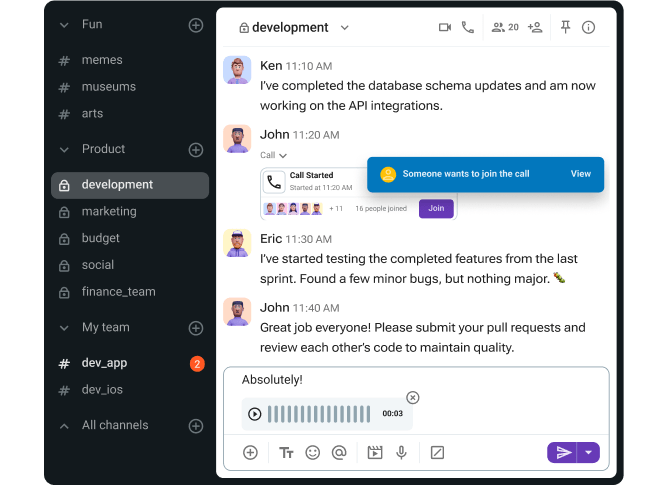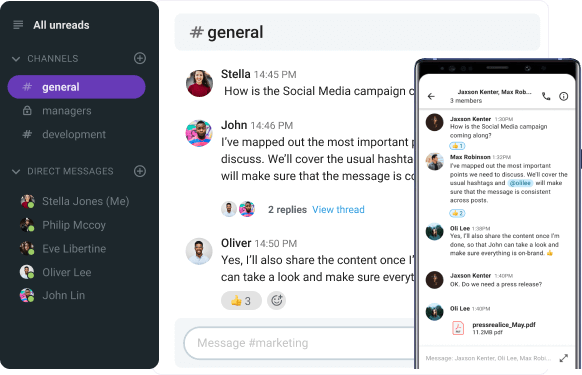Effective communication is the lifeblood of every organization. We use it to:
- Communicate new policies to employees,
- Prepare different departments for upcoming changes, and
- Help teammates bond with one another.
All of this would be exceedingly difficult without organizational communication.
To learn what organizational communication entails and how best to manage it to solve business problems, we’ll explore questions like:
- What are the 4 types of organizational communication?
- Why is organizational communication so important?
- How can you improve organizational communication?
We’ll also explore best-practice examples to give you a blueprint for successful communication. But before we do that, let’s start at the beginning.

Table of Contents
What is organizational communication?
Organizational communication refers to the different channels and forms of communication that organizations (such as corporations, non-profits, and governmental bodies) engage in. As such, it includes both internal and external communication.
Because all participants — the employees — work toward a set of common goals, communication becomes the central nervous system of the company. As a result, organizational communication helps us:
- Complete tasks relevant to our positions and responsibilities,
- Facilitate change and crisis management strategies,
- Maintain procedures necessary for undisrupted operations,
- Nurture fruitful relationships with employees across all levels of the organization, and more.
Let’s expand this definition further by exploring the different types of organizational communication.
Types of organizational communication
We can classify organizational communication into 4 groups:
- Directional communication,
- Formal and informal communication,
- Internal and external communication, and
- Oral and written communication.
Here’s an in-depth look at each.
Directional communication
Directional communication can take on 4 flows, branching off into:
- Upward communication,
- Downward communication,
- Horizontal communication, and
- Diagonal communication.
Upward communication starts at the lower level of company infrastructure, encompassing how employees communicate with management and leadership. Thus, it’s essential to ensure everyone is aware of official policies regulating discussions with senior and high-ranking employees. This also includes informing staff of the most efficient methods for:
- Providing feedback,
- Seeking advice, or
- Contacting senior employees.
On the opposite side, we have downward communication, which takes place from the top down. In other words, whenever a person in charge communicates with those lower in the hierarchy than them, we have a case of downward communication. It’s often described as executive communication, and leaders typically work with PR specialists and media training coaches to keep their messaging consistent.
Another case is horizontal or lateral communication, which happens whenever we communicate with our peers.
Finally, diagonal communication involves members of different teams and departments interacting together, without following strict hierarchical rules (e.g., a customer support agent speaking with an engineering manager).
However, organizational communication can also differ in levels of formality, leading to further divisions.
Formal and informal communication
Formal communication typically follows a strict set of predetermined rules. Consequently, it has a recognizable and uniform structure, spelling, and tone, and is usually conducted through official channels, such as:
- Emails,
- Meetings,
- Conference calls,
- Speeches,
- Memos, and more.
💡 PUMBLE PRO TIP
To learn more about formal communication, head to this guide:
On the other hand, informal communication (or grapevine communication) doesn’t adhere to a strict set of rules, leading to more low-pressure and spontaneous conversations, which include:
- Watercooler chit-chat,
- Messaging via business communication platforms,
- Phone calls, and more.
Need a reliable business messaging app? Try Pumble
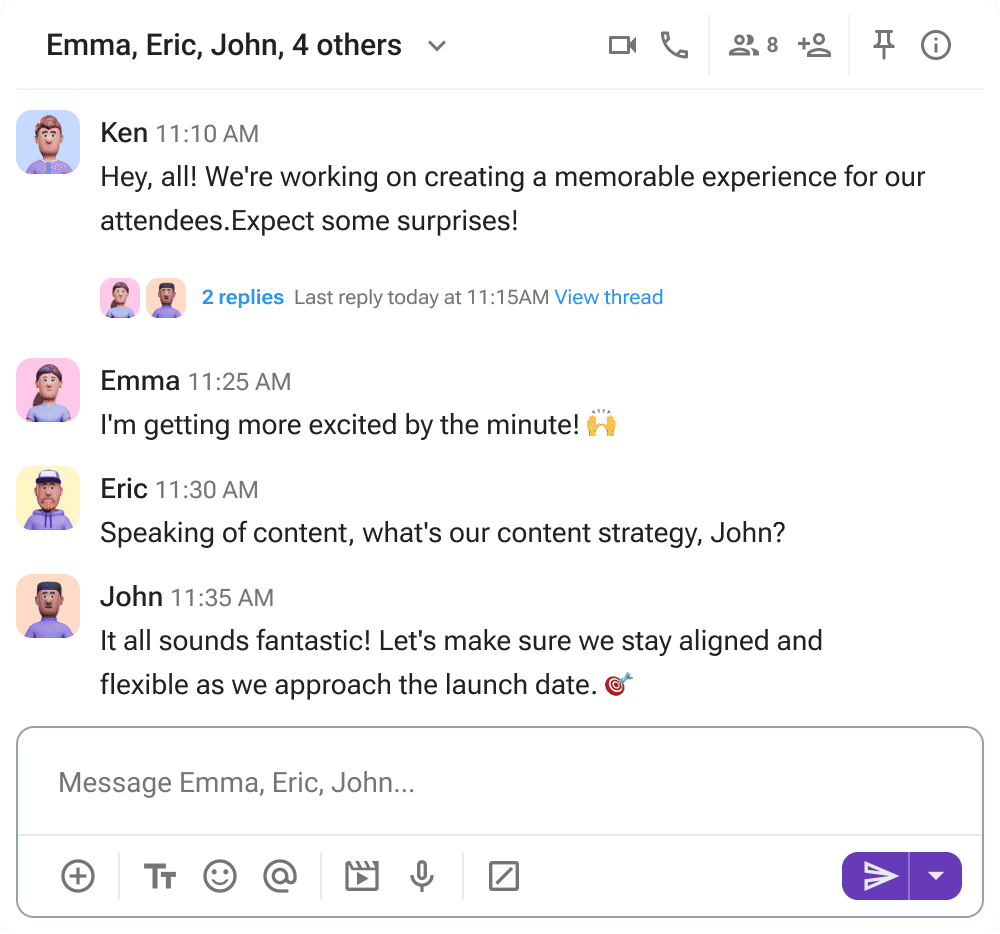
There’s another factor we should consider when classifying organizational communication — whether we’re speaking to another member of our organization or a third party.
Internal and external communication
Organizational communication can be internal or external, depending on the audience — that is, who employees are talking to.
For example, if employees are interacting with one another, within the organization, that’s a case of internal communication. This encompasses various communication and collaboration activities, including:
- In-person meetings,
- Video calls,
- Instant messaging, and
- Emailing.
When the employees communicate with someone outside their organization, we’re talking about external communication. It includes activities designed to preserve a brand’s reputation and standing, such as:
- PR announcements,
- Job posts,
- Marketing materials, and
- Communication with stakeholders.
Make external communication easier with Pumble
💡 PUMBLE PRO TIP
With remote and hybrid work becoming widespread, it has become increasingly important to connect with external collaborators such as contractors, freelancers, and partners. But emails and phone calls just don’t cut it, especially if everyone operates from different time zones. To make collaboration simple, apps like Pumble have introduced guest access, a feature that removes barriers and helps organizations connect with external collaborators and agencies. To find out more, check out this resource:
Oral and written communication
Oral and written communication are both integral parts of organizational communication.
Face-to-face communication that takes place between colleagues, or between employees and customers, constitutes oral or verbal communication. It plays a significant role in building both personal and business relationships.
Written communication, both formal and informal, occurs via:
- Emails,
- Instant messages, and
- Social media.
In contrast to oral communication, it is more structured but may be less personal.
These divisions make sense in theory, but what is an example of organizational communication?
Organizational communication examples
Our daily work life is full of examples of organizational communication.
Here are some common instances:
- Team meetings: If teams are to stay in sync, it’s important that they meet on a regular basis (whether that be weekly, monthly, etc.). That way, teammates have a dedicated slot for discussing what they’re currently working on and for providing help to one another if needed. Chances are your team already has regular meetings. So, you’ve been practicing organizational communication, although you might not have known it.
- Feedback: Constructive feedback also falls under organizational communication, with activities ranging from polls and surveys to performance reviews and Q&A meetings.
- Social events: Team-building gatherings and similar events are another segment of organizational communication, although such activities are mostly informal.
- Onboarding: Whether you’re welcoming a new employee virtually or in person, the onboarding process is another example of organizational communication.
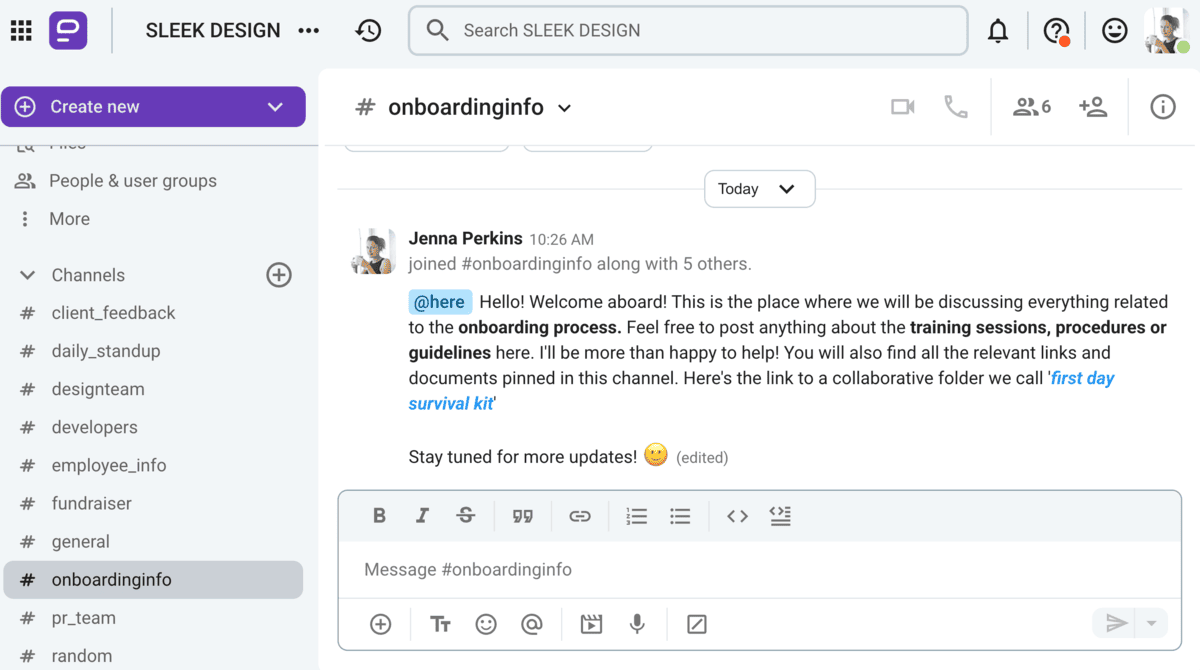
Simplify employee onboarding in Pumble
Now that we’re familiar with several examples, it’s time to discuss the impact and importance of organizational communication.
Why is organizational communication so important?
Without effective communication, there is no successful organization.
In his book Administrative Behavior, American social scientist Herbert A. Simon claims that the main role of organizational communication is to battle the glut of information so that we can identify the most important messages.
This claim is especially relevant for modern work, particularly in remote communication, where information overload can be rampant. Because we want to ensure our message gets across, we sometimes strive toward overcommunication, potentially falling victim to information overload.
To stay on the right track, we need effective organizational communication. The benefits of strong communication not only help teams maintain their performance but can also help them exceed expectations.
So, what benefits can we expect to see?
Stronger employee morale
Organizational communication gives employees a voice, which is an increasingly meaningful part of improving employee morale and satisfaction. When employees feel they have opportunities to speak their minds without negative consequences, their overall job satisfaction improves. These positive sentiments can then lead to higher engagement and retention.
💡 PUMBLE PRO TIP
What do morale, engagement, and retention have in common? They’re all part of employee experience, which influences how employees feel about their jobs. For more information on the topic, check out this guide:
Fewer misunderstandings
Effective organizational communication minimizes the chances for miscommunication and paves the way for transparent communication among employees. When there’s a free flow of information in an organization, the entire workflow becomes more streamlined. This gives teams the tools to eliminate information silos — a hallmark of poor communication.
Say goodbye to information silos with Pumble
This naturally leads us to the next benefit of organizational communication — greater efficiency.
Greater efficiency
In our search for answers, we reached out to Dominic K. Hawkins, a communication strategist, who shared with us his opinion on the importance of two-way communication in organizations.
He highlighted that when you remove that connective tissue — organizational communication — employees can start to feel resentment and disappointment in management for failing to hear them out. Similarly, unless higher-ups manage to secure employee buy-in, no meaningful change can take place.

“Organizational communication channels allow the free flow of information between all levels and teams of an enterprise to increase operational efficiency, and ultimately yield higher profits.”
Operational efficiency and higher profits are both a direct result of enhanced productivity.
Higher productivity
Effective organizational communication helps companies reach their business goals and positively impacts productivity by minimizing errors and simplifying collaboration.
Moreover, according to our workplace communication statistics, an impressive 64% of business leaders believe communication has a positive effect on productivity.
Clearly, having your employees learn how to become effective communicators is worth the extra effort. It’s a cost-effective way to improve productivity, as well as build a supportive and motivating work environment.
Now, which steps should you take to reap these benefits and implement an effective organizational communication strategy?
💡 PUMBLE PRO TIP
Improving productivity is easier said than done. Luckily, the below guide is here to help you get a headstart:
How to create an effective organizational communication strategy?
To travel far, you need a strong team. And to build a strong team, you need to work on your communication. It really is as simple as that. But we’ll break down the process into 7 easy-to-follow steps.
Step #1: Use great communication tools
What is the role of technology in organizational communication? If you want to unite your workforce, you’ll need the best communication tools.
Whether you’re building a small business or leading an ambitious enterprise, a reliable business messaging app makes communication:
- Engaging,
- Efficient, and
- Transparent.
Pumble by CAKE.com — business communication made easy
Depending on the occasion and the information you want to share, you might need to mix up your communication channels.
You’ll want a tool that can simplify your tech stack. Instead of using several instant messaging apps, look for a platform rich with multiple communication features, such as:
- Direct messages,
- Video conferencing, and
- Voice calls.
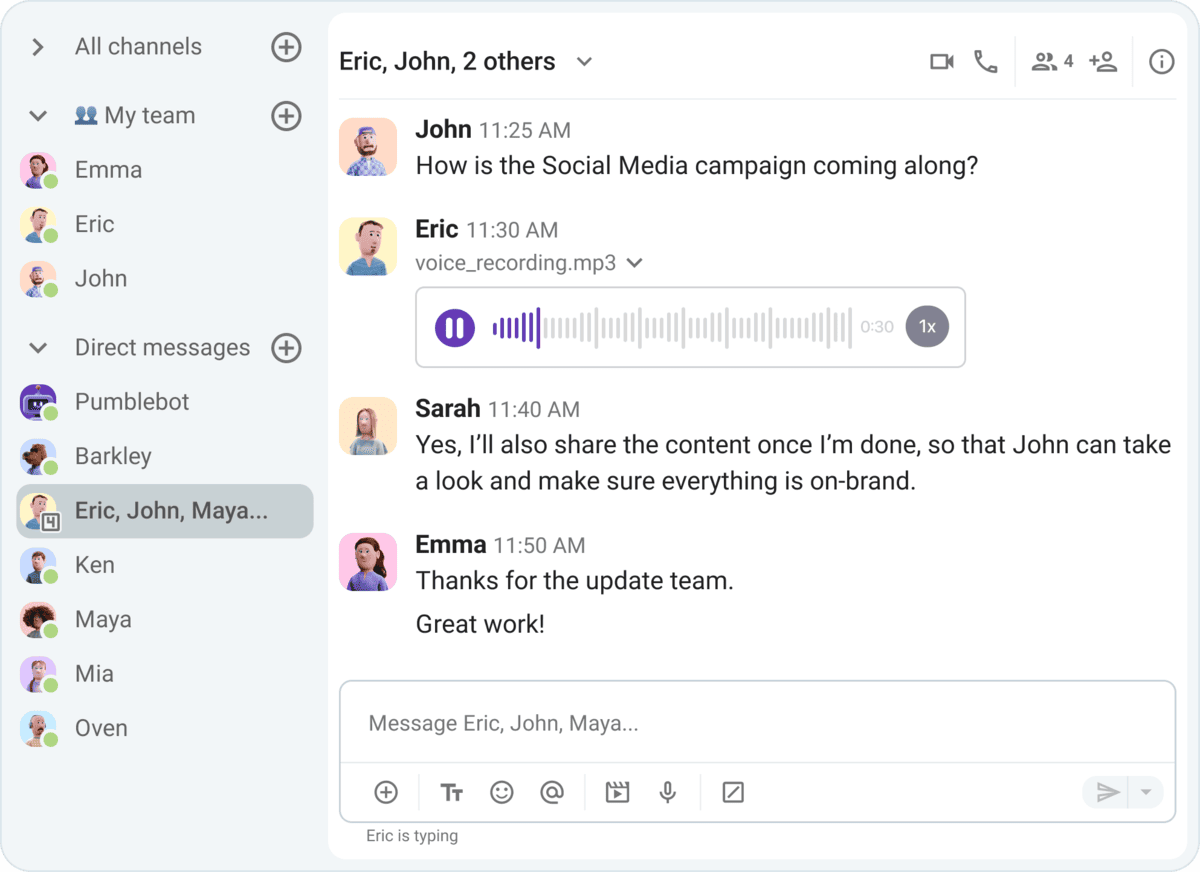
A feature-rich internal communication app keeps everything in one handy place, meaning you can also cut down on lengthy email chains. Your goal is for your messages to reach each and every one of your employees, whether they’re working remotely, hybridly, or in the office.
Step #2: Meet with employees regularly
Regardless of your work model (i.e., hybrid or remote), prioritize holding regular meetings with your team. After all, communicating your organization’s mission, goals, and values isn’t a one-and-done task — you need to demonstrate your commitment to clear and open discussions consistently.
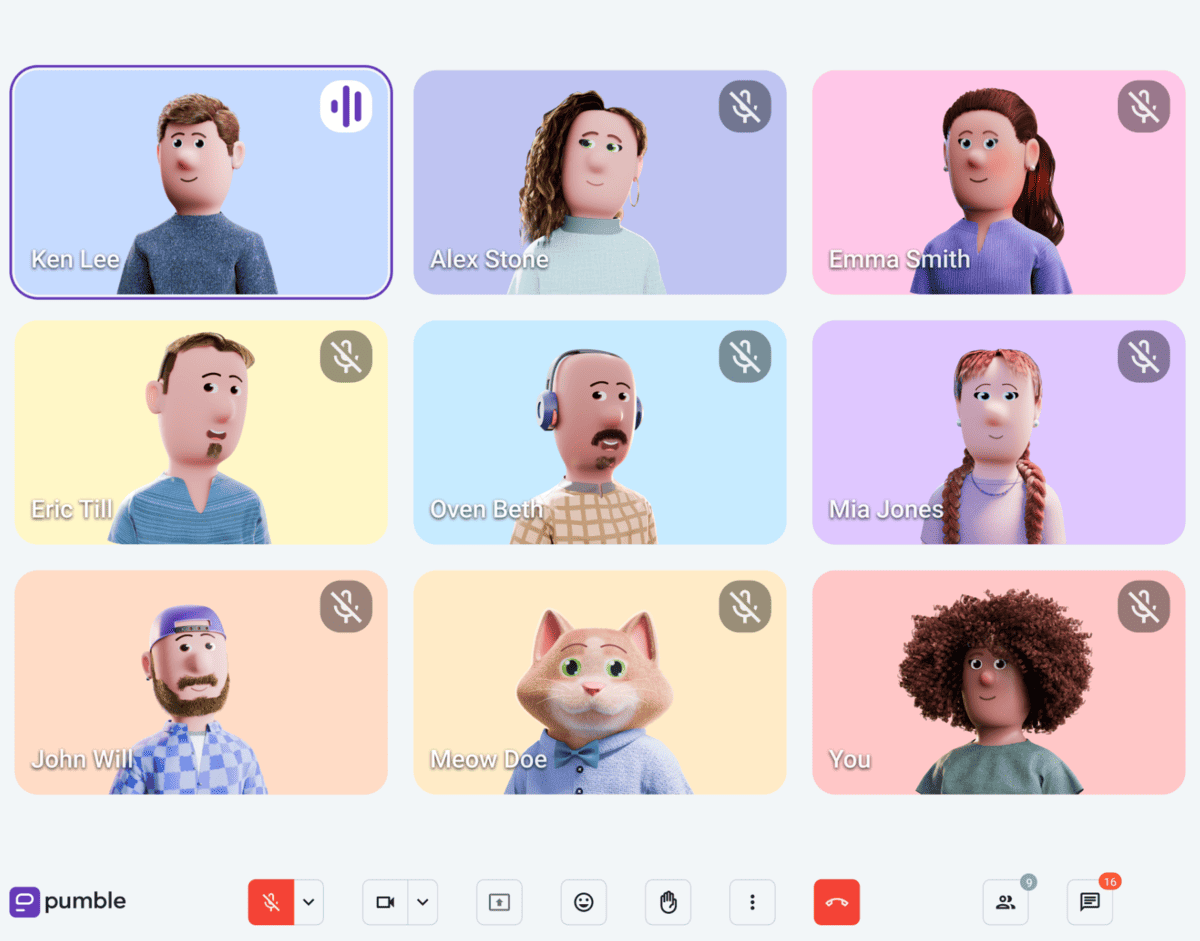
Admittedly, that’s not always the easiest task, especially if you’re in charge of geographically dispersed teams. Thanks to group video calls, though, you can reintroduce that much-needed face-to-face element into corporate communication to keep everyone engaged. You can do more than just switching on your camera by:
- Sharing your screen for presentations,
- Organizing virtual team-building activities,
- Holding town halls and Q&As to maximize transparency and accountability, and
- Giving everyone a chance to ask for clarification in real time via in-meeting messages.
Make engaging video calls in Pumble
Not all meetings have to deal with business. Even an impromptu meeting can go a long way in:
- Ensuring the team stays well-connected,
- Keeping the pressure off employees, and
- Making work feel more pleasant.
Step #3: Recognize achievements
A healthy work culture, along with effective organizational communication, isn’t possible without employee recognition.
Namely, to motivate your coworkers and keep morale high, it’s paramount that you acknowledge their achievements and contributions.
If you do that publicly, even better — you’ll show everyone what kind of behavior and values are fostered in your organization. This is an important step towards creating a transparent work culture, where the company’s vision and mission are clear to every member of the team.
💡 PUMBLE PRO TIP
Celebrating milestones — however big or small — tells employees that their presence makes a difference. To see how such acknowledgements boost employee retention and engagement, check out this blog post:
Step #4: Give clear instructions
Fyodor Dostoyevsky once said: “Much unhappiness has come into the world because of bewilderment and things left unsaid.”
That’s not the kind of atmosphere you want in your workspace. So, to avoid misunderstandings and streamline workflows, communicate expectations clearly.
Don’t expect your coworkers to read your mind. Leave multiple lines of communication — like direct messages, channels, and threads, for example — open so that you can easily address any points of confusion.
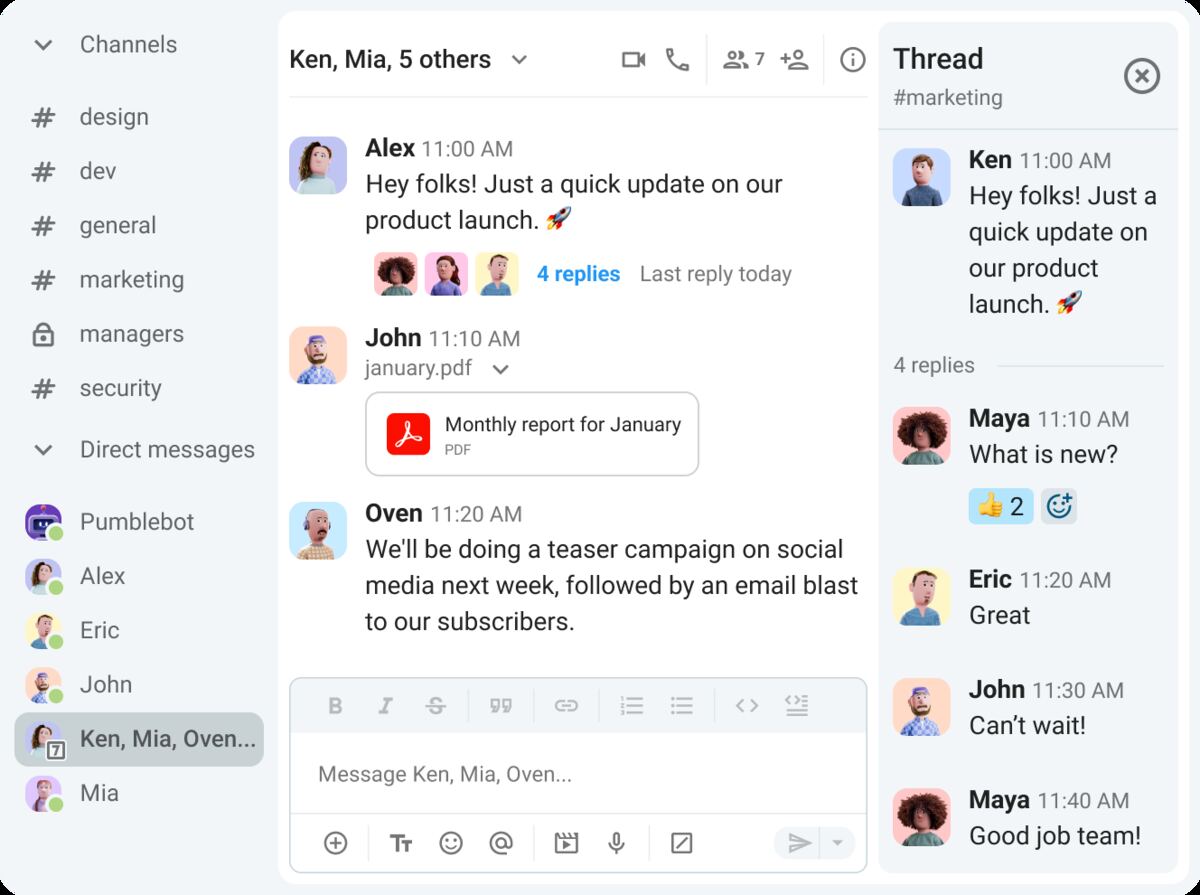
Don’t let your team spiral with misdirected efforts. Keep your digital door open and amplify everyone’s ability to ask questions.
Step #5: Create an open environment
By making yourself more visible and accessible, you create an open environment in which each of your coworkers feels comfortable to speak their mind.
Establishing an open-door policy is a sure way to promote transparent vertical communication, which helps you become a leader who:
- Communicates well,
- Listens attentively, and
- Retains top talent.
Because everyone is encouraged to share feedback or insight, this open environment also helps coworkers build stronger relationships among themselves — a prerequisite for effective organizational communication.
In such an environment, the company’s trajectory becomes clearly visible, so each team member can see how their role contributes to the bigger picture.
Step #6: Use visuals
Organizational communication becomes even more effective when you bring in visuals like graphics and similar aids, such as:
- Polls,
- Video messages,
- Screen recordings,
- Video files,
- GIFs, and
- Emojis.
Incorporating these visual elements into your everyday internal communication adds personality and tone, as well as lightens the mood and further contextualizes content. All you have to do is add videos, infographics, or GIFs into your daily correspondence and enjoy the fruits of your labor.
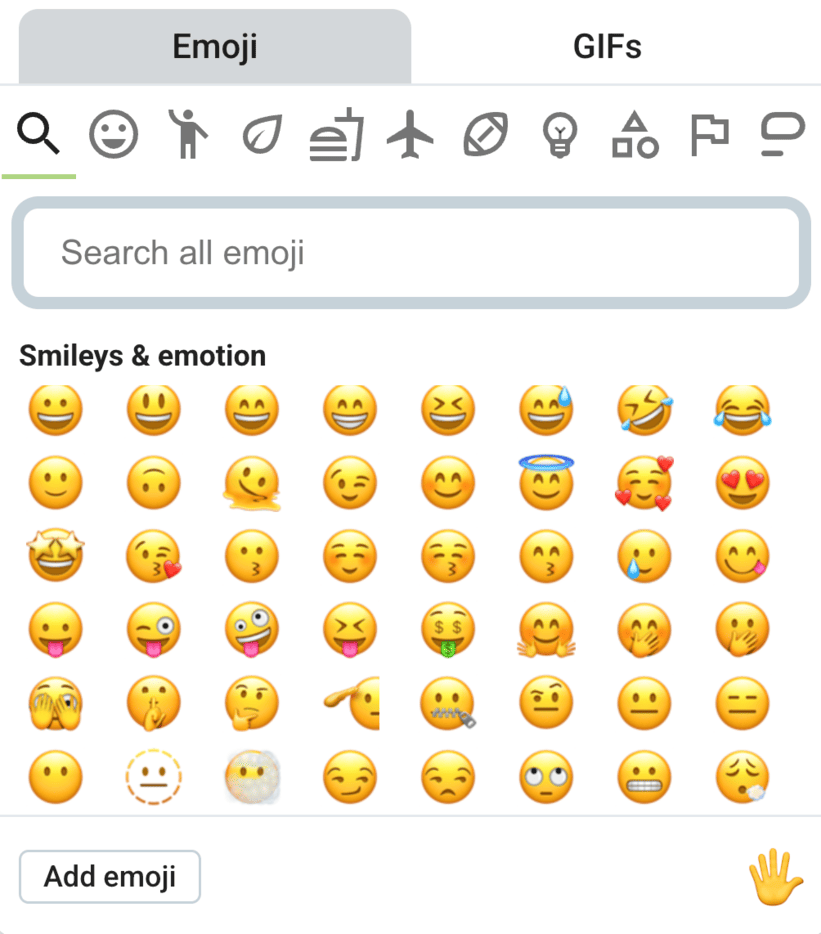
And if your coworkers are comfortable with the use of emojis in the workplace, you can join the 92% of the internet population who use emojis in their everyday communication.
💡 PUMBLE PRO TIP
If you’re unsure whether emojis belong in the workplace, check out our in-depth articles:
Step #7: Be open to feedback
In addition to offering feedback to your coworkers, you should also be open to receiving it.
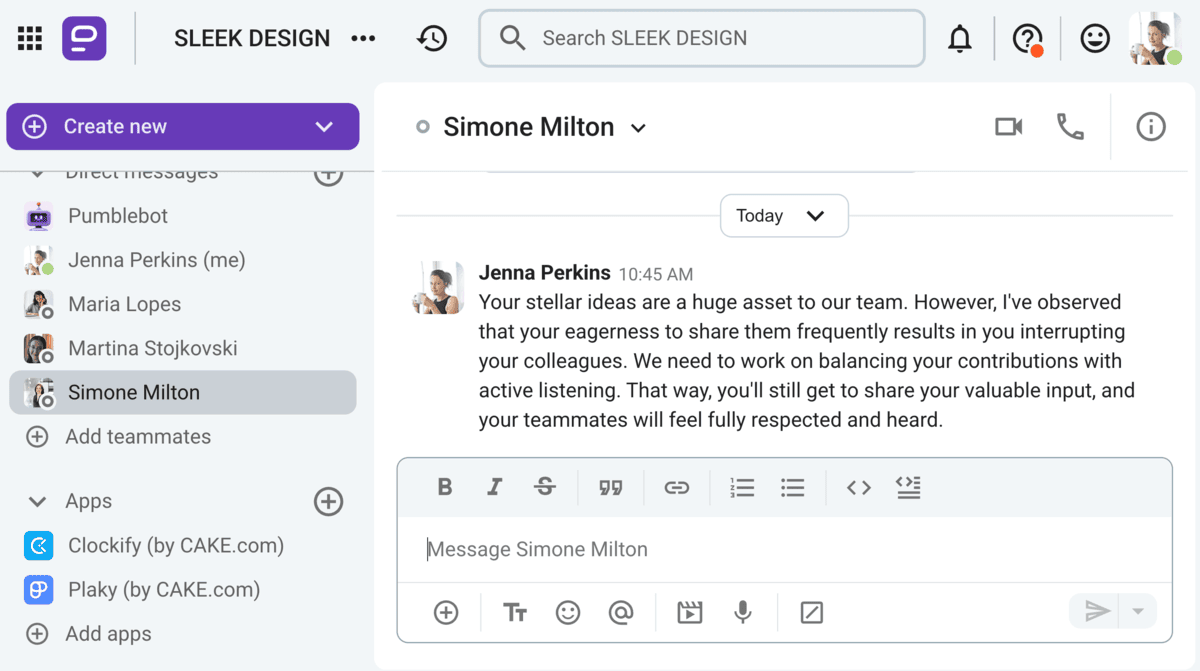
As we’ve already mentioned, communication should be a two-way street, with no one grasping for information in the dark. When communication works well, everyone is in tune with the rhythm of your organization, enabling you to put all your business plans into action.
Most importantly, don’t get locked in a bubble where no employee feedback can break in. The lack of response and attention could push them to:
- Look for information on their own, or
- Disregard your opinion.
The good news is that you don’t have to do all of this alone. Communication apps like Pumble have robust features that can help you easily implement an optimal organizational communication strategy.
💡 PUMBLE PRO TIP
To learn how to make the most out of feedback in the workplace, see these guides:
Stay organized with Pumble
Not only does communication help teams reach new business heights, but it also shapes organizations into powerful forces equipped with creativity and adaptability.
And, to ensure that your communication is as organized and efficient as can be, your team can try Pumble to:
- Streamline communication,
- Eliminate unnecessary emails, and
- Easily share and search for files and messages.
With Pumble, you don’t have to choose between video conferencing or messaging. Get the best of both in one easy-to-use app.
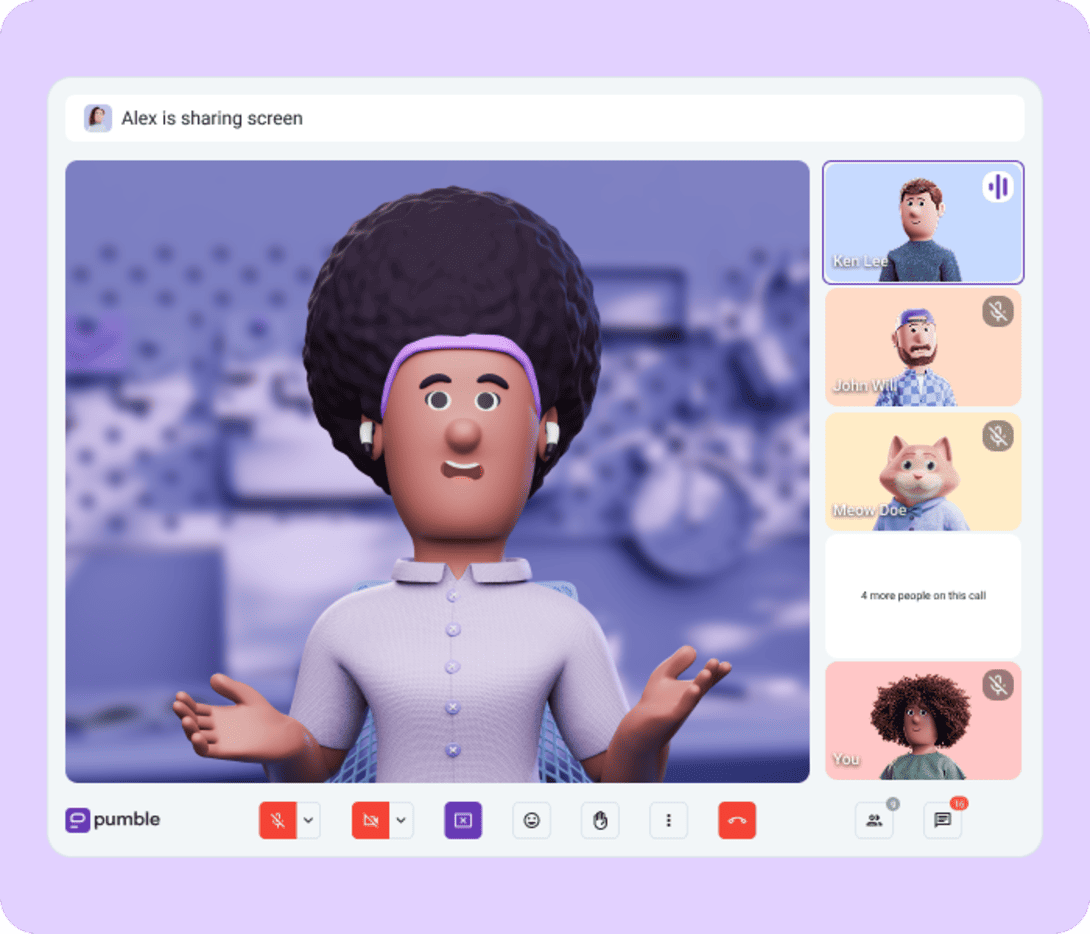
We’ve learned that disruptions are detrimental to effective communication. When it comes to communication apps, a major obstacle can be how quickly the entire workforce can adapt to the software. In many cases, non-technical users see it as a hindrance, not an asset.
That’s exactly the experience Pumble helps teams avoid. No matter your level of technical skill, you’ll be able to spot Pumble’s core features without trouble, as most of them are organized in the left-hand sidebar.
Restructuring organizational communication doesn’t happen overnight, but it doesn’t have to be tedious, either. Take the leap and fuel productivity.



